My Cube is a labor of love in pursuit of discovery. Playing the Drafts, talking to players, reading theory, and extracting understanding from the data—my appreciation for the finer points of the game only grows.
This update is the most dramatic and comprehensive I’ve ever attempted. I also believe it’s the most successful. Here’s the scoop:
- There were twenty total card increase: four per color.
- Over forty new cards, from Avacyn Restored and many other sets, are introduced.
- Overall mana curves by color, and across colors, were refined.
- Archetypes were introduced and improved.
I didn’t take this update lightly, and I wasn’t waiting around to finish it. I had the cards changed up in time for Grand Prix Minneapolis and Grand Prix Anaheim, so I was able to receive some feedback post-changes. Spoiler alert: Results are promising.
This review will cover things in a natural sequence:
I promise to be brief where possible, but you can find additional details in the update analysis spreadsheet.
If video is your thing, you can get acquainted with pauper cubes through this video from Grand Prix Minneapolis courtesy of ChannelFireball:
Let’s get started.
Initial Outlook and Concerns
Drafts were less interesting than I wanted them to be. There were a couple of reasons for this, all of which were my fault.
- Boring, but solid, cards sat in some colors. Nessian Courser exemplified this.
- There was minimal synergy between colors. The ability for cards to stand alone was rated significantly higher than their archetype potential.
- Mana curves weren’t measured carefully. Several colors, namely blue and red, clumped at some costs.
Each of these issues was something that could be addressed easily with some thought. So that’s what I did. The process involved asking and answering several questions for each color.
- How does the mana curve look?
- What does this color want do with other colors?
- Which cards make a better mana curve and play experience happen?
The answers weren’t always easy or intuitive. And to show where we started, this is what the mana curves looked like:
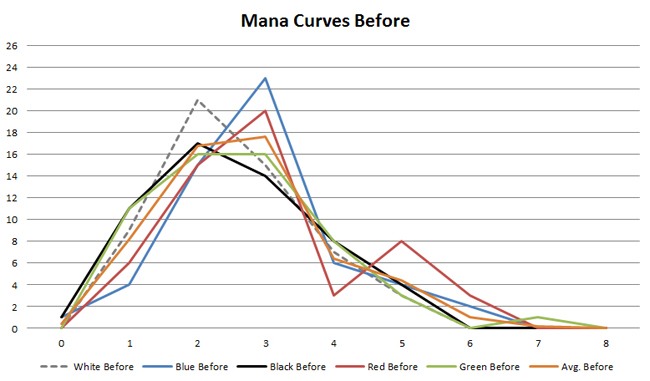
I’ll point to the issues in each color when we get to them, but it’s clear here that the colors were not balanced in terms of accessibility to early-game efficiency. Every color should have things to do early, and those things should be useful to its goals.
Forming general goals by color comes down to looking at every color pair as its archetype and then committing to make those archetypes enticing:
| Pair | Primary Archetype | Secondary Archetype |
| W/U | Tempo | Control |
| U/B | Control | Tempo |
| B/R | Aggro | Control |
| R/G | Aggro | Midrange |
| G/W | Aggro | Ramp |
| R/W | Aggro | Control |
| U/R | Tempo | Control |
| G/U | Ramp | Midrange |
| B/G | Midrange | Control |
| W/B | Aggro | Control |
I won’t review how each of these archetypes looks or works, but I am creating a deck map that shows the most important cards for the representative deck. For our purposes, improving these two end games for the color pairs—by updating the five colors individually—was the invisible hand at work improving the play experience.
Play experience is slightly subjective, but I define it in terms of how others enjoy the Cube. The most common negative feedback I’ve received is that there doesn’t appear to be much to do in each color beyond its obvious deck. Cards that serve interesting functions that support a wider variety of decks are required.
Nessian Coursers aren’t interesting in that way.
The end result, as a teaser for later, was this:
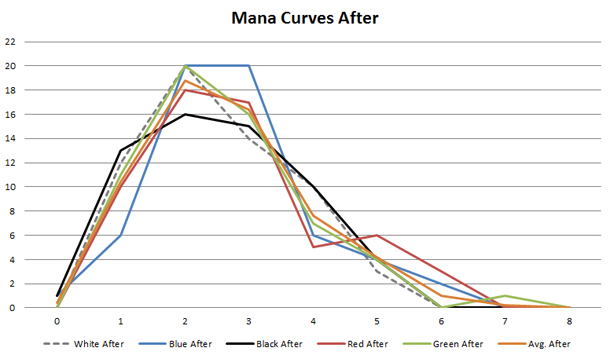
Smoother, more efficient play and clearer tools for gameplay are exactly what a Cube update should strive provide every time. Here’s how I did it for mine.
White
White is clearly an aggressive color in Limited. Time and time again, efficient weenies—often with abilities or keywords—fill out the curve of white Draft decks. A Pauper Cube is no different, but that doesn’t mean white is one-dimensional.
The other features it has access to—high-toughness creatures and life-gain—are well suited for supporting a control archetype. These changes enhance control while still supporting aggressive means.
| WHITE | |||
| OUT | IN | ||
| Name | CMC | Name | CMC |
| Steppe Lynx | 1 | Soul's Attendant | 1 |
| Ronom Unicorn | 2 | Soul Warden | 1 |
| Kami of Ancient Law | 2 | Youthful Knight | 2 |
| Order of Leitbur | 2 | Knight of Cliffhaven | 2 |
| Razor Golem | 3 | Seraph of Dawn | 4 |
| Coalition Honor Guard | 4 | ||
| Daru Lancer | 4 | ||
| Cloudshift | 1 | ||
| Righteous Blow | 1 | ||
Note: All converted mana costs are “effective” or “actual CMC” as per the usual amount of mana one would expect to pay. “Printed CMC” is what appears on the card. Nobody should set cards such as Daze at their printed costs for a Cube.
The major changes here are bringing in three spells that will probably gain significant amounts of life over games: Soul's Attendant, Soul Warden, and Seraph of Dawn. These three are excellent cards in their own right, but together, they form a backbone of life that resists black and red decks. High-toughness and first strike creatures can play defensively, but Youthful Knight, Knight of Cliffhaven, and Daru Lancer also work as aggressive on-the-curve drops.
Cloudshift is nutty with all of the enters-the-battlefield triggers in the Cube, and Righteous Blow is some instant-speed removal that works in a world of small fries.
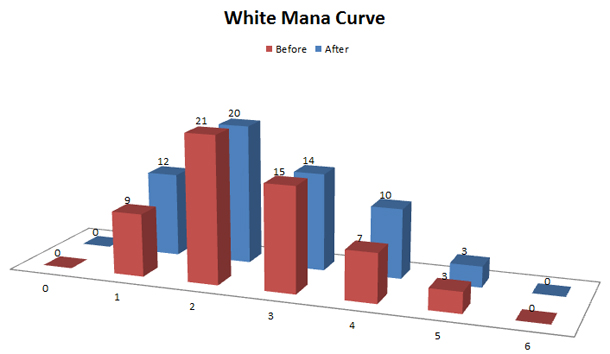
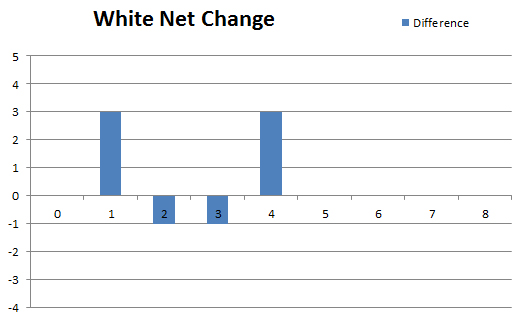
More 1-drops, better 4-drops, and a smoother total curve. This looks much better.
Blue
There’s only so much efficient aggro that blue can do, most of it coming with a significant tempo loss. Instead of fighting for an entirely more aggressive blue, reinforcing its ability to delay, stabilize, and survive only feels fair.
This means both control and tempo decks will use bouncing and tapping to suppress faster decks, giving time for blue to go over the top with bigger flying creatures and card quality. These changes enhance all these capabilities.
| BLUE | |||
| OUT | IN | ||
| Name | CMC | Name | CMC |
| Phantasmal Bear | 1 | Silent Departure | 1 |
| Fathom Seer | 3 | Ponder | 1 |
| Trespassing Souleater | 3 | Skywatcher Adept | 1 |
| Chasm Drake | 5 | Spectral Prison | 1 |
| Impulse | 2 | Snap | 2 |
| Neurok Stealthsuit | 2 | Prohibit | 2 |
| Repulse | 3 | Cloud of Faeries | 2 |
| Bone to Ash | 4 | Thought Courier | 2 |
| Merfolk Looter | 2 | ||
| Echo Tracer | 3 | ||
| Mist Raven | 4 | ||
| Gryff Vanguard | 5 | ||
There is a lot going on here, but blue deserves its chance to shine brightly. The Looters and Ponder should fortify blue’s ability to maintain an advantage in the average strength of its draws. Bone to Ash isn’t a bad card but Prohibit in either mode will hit significantly more of the potential cards.
Additional bounce spells, particularly Silent Departure, will allow a very controlling deck to determine what stays in play and gets to attack. Departure, Snap into Prohibit, Aether Adept, Mist Raven, flashback Departure into Capsize, Aethersnipe, or Echo Tracer seems like an incredible line of plays. Do you disagree?
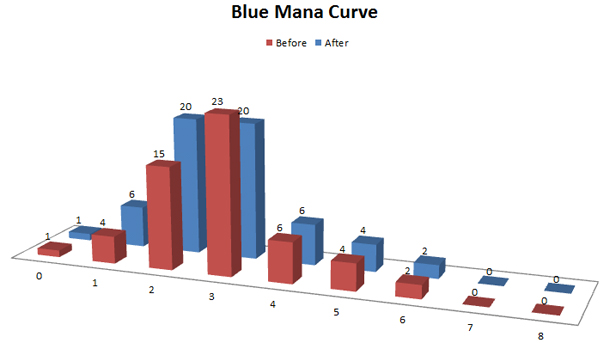
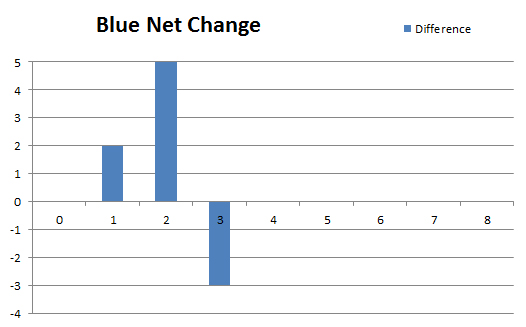
The massive, painful clump at 3 has been normalized as 1- and 2-drops were boosted. Blue’s power at converted mana cost 3 and above is probably better, on average, than the other colors . . . at least that’s the general idea.
Black
Black is problematic for a very difficult-to-solve reason: double-color-requirement cards. Its curve wasn’t that bad, so it stayed relatively similar through the update. However, it’s still deceptive.
Cards requiring a double-color cost can actually end up costing more in terms of a virtual mana cost. Curving out is awesome because it’s mana-efficient: You’re using your resources to their fullest every turn. This wisdom has been passed down from Magic luminaries such as Jon Finkel and Limited specialist such as Marshall Sutcliff. It’s the basis of all modern Limited theory, and it’s often a very important consideration for Constructed.
But as you try to curve out, if you have to wait to draw into a second source of a color of mana, you’re handicapping your ability to cast the correct or desired spells on the curve. Playing the appropriate threats in the appropriate order is a powerful tool players can wield. Put another way, a Highborn Ghoul on turn three usually isn’t as sexy as turn two, especially if you want to do something else on that turn.
Waiting to be able to cast spells is a drag. While some see the black-wants-more-black aspect as a feature, I find it to be an annoying bug when I’d rather have the color play nicer with others.
| BLACK | |||
| OUT | IN | ||
| Name | CMC | Name | CMC |
| Order of the Ebon Hand | 2 | Typhoid Rats | 1 |
| Grasp of Darkness | 2 | Butcher Ghoul | 2 |
| Victim of Night | 2 | Soulcage Fiend | 3 |
| Undead Executioner | 4 | ||
| Driver of the Dead | 4 | ||
| Innocent Blood | 1 | ||
| Terror | 2 | ||
Three double-color spells went out; one came in. It’s not a particularly steep change, but it’s a fine start. Black is powerful, and of all the potential mono-colored decks, I feel strongly black would have the most powerful tools. These new cards only fuel that possibility.
All of the new creatures introduced provide leverage for black: Typhoid Rats and Undead Executioner are most definitely removal, and both Soulcage Fiend and Driver of the Dead are problematic for opponents to block. Butcher Ghoul is a creature that slides in perfectly for the U/B and B/G decks but is serviceable in more aggressive builds as well.
Both Innocent Blood and Terror are returning to the Cube. Terror is less powerful than the outgoing Victim of Night, but it is immensely easier to cast. Similarly, Innocent Blood isn’t a Grasp of Darkness, but its casting cost plays nice, and the card provides synergy to some archetypes.
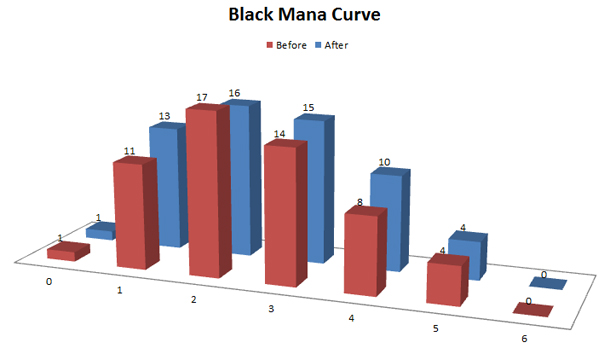
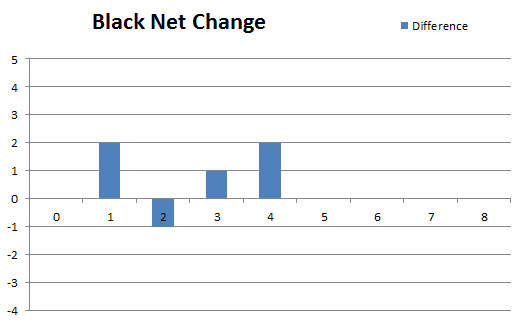
Black’s curve was deceptively solid before. Unfortunately, a simply mana curve doesn’t show the overwhelming color commitment black bears. A slight tweak to emphasize available options in the early turns is all that was needed.
Red
Red is often considered in a one-dimensional way for Cubes: as glass-cannon creatures backed by a slew of burn spells. This characterization isn’t necessarily untrue, but that doesn’t mean depth and variety can’t be found.
The Alex Ullman-Seth Burn Pauper Cube Approach to Red relies on making red more midrange, with Hill Giant and 5-drop creatures shining on the forefront. However, it didn’t feel like what red really wanted. Red is as miserable as green in traditional evasion—flying—and trying to make red play more like green was a fool’s errand: Red’s creatures aren’t as efficiently sized as green’s anyway.
The newest strategy I settled on was to reinforce three main ways red can interact to create evasion:
- First strike – Red has more and more, and most players won’t block unless they have tricks or are in chump-blocking mode.
- Haste – Red is the champion for this, and creating a constant pressure through aggression suits red much better than random big guys.
- “Target creature can’t block this turn” – It’s a pseudo-tapping ability that combines well with both of the other two domains red now owns. Removing the problematic blocker while adding an unexpected attacker is a winning synergy.
If I need to make it explicit here: Avacyn Restored was a boon for red to up the count on everything listed above.
| RED | |||
| OUT | IN | ||
| Name | CMC | Name | CMC |
| Inner-Flame Acolyte | 3 | Somberwald Vigilante | 1 |
| Oxidda Golem | 3 | Skitter of Lizards | 1 |
| Skirk Shaman | 3 | Goblin Bushwhacker | 2 |
| Vulshok Replica | 3 | Dragon Fodder | 2 |
| Nearheath Stalker | 5 | Ashmouth Hound | 2 |
| Hanweir Lancer | 3 | ||
| Fervent Cathar | 3 | ||
| Mad Prophet | 4 | ||
| Rukh Egg | 4 | ||
Similar to blue, red had some clumping at 3 mana. Smoothing that out while expanding the elements for some archetypes gave red much more depth than before.
Somberwald Vigilante and Skitter of Lizards give aggressive red decks traditional 1-drops, with Dragon Fodder, Ashmouth Hound, and Goblin Bushwhacker providing backup. Hanweir Lancer and Fervent Cathar are excellent replacements at the 3 slot, letting the midgame be controlled by extra first strike, haste, and blocker removal.
Mad Prophet and Ruhk Egg are two cards that seem fairly flexible. While the Prophet is going to be doing some looting, he’ll do the most work in a U/R deck that’s digging for an answer. Similarly, a 0/3 4-drop will be blocking, will be dying, and will be providing a massive aerial bonus, all of which work for a much less aggressive red-based deck.
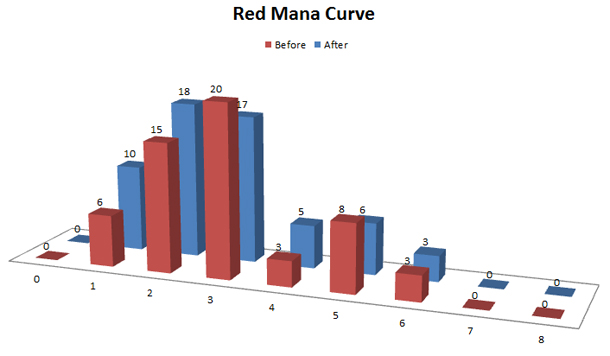
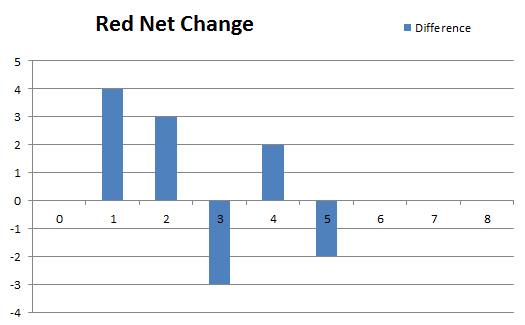
Massaging red will take additional updates to work out, but this is a huge leap in the right direction. There are more 1-drops, 2-drops outnumber 3-drops, and the 4-and-more-drops are varied in utility.
Green
It’s taken me the entire development cycle of the Pauper Cube to appreciate and refine blue to be a color that can stand on its own. In an ironic twist, despite loving the color, I don’t think green’s identity has been really discovered.
Make dudes. Attack often. Your dudes are bigger. Your dudes are more plentiful. But by the way, you can ramp and mana-fix uniquely on your own. The advantages to either of the latter are dubious at a glance. What makes a ramp deck excel? Why would you want to play three or more colors?
This update is consistent with the current inertia of green’s philosophy of increasing creature utility and variety. The process of developing the update led me to realize the questions I asked above. Answering them will probably involve the same type of overhaul that blue underwent and shift the overall philosophy of the color.
A little more input, feedback, and research will be needed for before I reboot anything.
| GREEN | |||||
| OUT | IN | ||||
| Name | CMC | Name | CMC | ||
| Nessian Courser | 3 | Nightshade Peddler | 2 | ||
| Timberland Guide | 2 | ||||
| Wall of Roots | 2 | ||||
| Wandering Wolf | 2 | ||||
| Trusted Forcemage | 3 | ||||
The changes here are very straightforward. A strong, but boring creature comes out for variety of more dynamic options. Timberland Guide and Trusted Forcemage can shift and defeat stalemates as well as beef up small fries into real threats. Wandering Wolf and Nightshade Peddler are green’s forms of evasion, and they combine well with a variety of things green already does. Wall of Roots is a ramp spell that also plays defender for dedicated ramp decks.
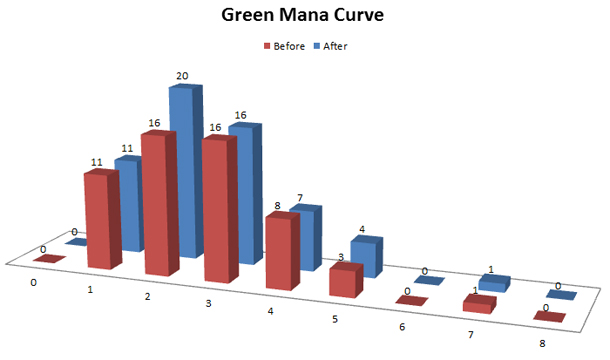
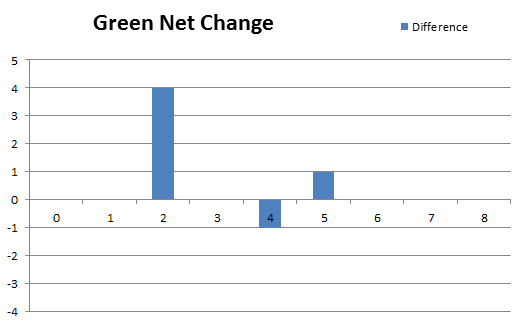
The 2-mana spot has been spiked appreciably. If a player is in green, though, he or she should have an abundance of creatures to choose from, each of which provides a different value. Again, it’s straightforward and sensible.
Overall Impact of Changes
Let’s look at the sets of before and after curves again.


The difference is abundantly clear and explained clearly within each color’s section. The aggregate of the changes obviously reinforced what can be deduced.
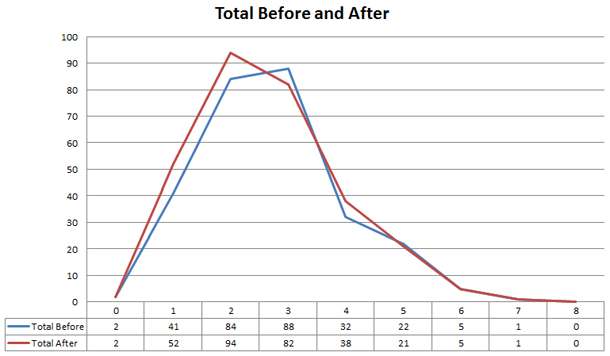
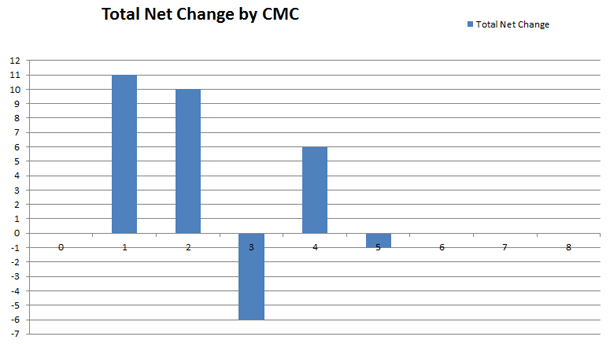
The 1- and 2-mana spells have been bolstered as 3-drops were trimmed away. Now all of the colors can curve out, engaging in more creatures earlier than before. A few additions at the higher mana costs provided powerful tools for slower decks to go over the top or slow the game down.
And thanks to both Grand Prix: Minneapolis and Grand Prix: Anaheim, some initial feedback is in:
- The life-gain cards added to white are the real deal. The every-burn-spell red deck has a counterpoint. And staying alive to fight green’s larger creatures isn’t as hard anymore.
- Blue can smoothly proceed through the early turns, and Skywatcher Adept is a brilliant 1-drop.
- Black still needs significant improvement in terms of mana requirements.
- Red has dynamic reach that doesn’t strictly require burn spells. Hanweir Lancer, Fervent Cathar, and Skitter of Lizards add considerable dimension.
- Green’s creatures are more interesting and useful, from Timberland Guide resetting a creature that persisted to Trusted Forcemage playing out in much the same way it does in Avacyn Restored Limited.
With Return to Ravnica on the distant horizon after Magic 2013, rebooting the multicolored options seems in order as well. And given the track record of putting powerful cards at common across most of the recent sets, I’m confident that changes are coming for all the color pairs.
If you want a complete spoiler for the cube, you'll find it here. If you have feedback or suggestions, please leave them in the comments below or send me an e-mail. Thanks!
























